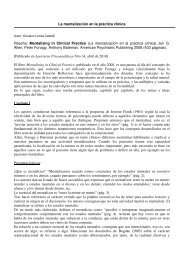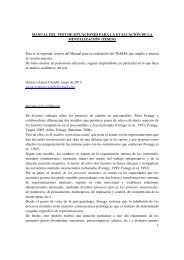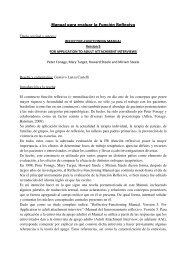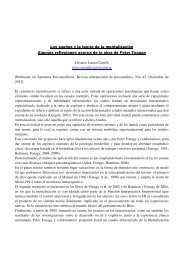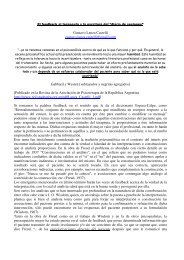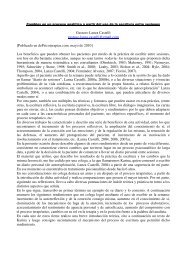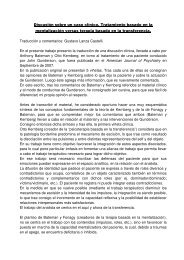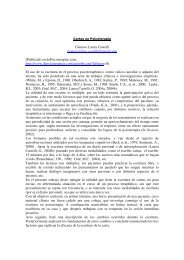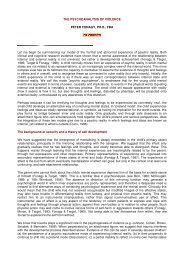Maternal Reflective Functioning, Mother-Infant Affective ...
Maternal Reflective Functioning, Mother-Infant Affective ...
Maternal Reflective Functioning, Mother-Infant Affective ...
Create successful ePaper yourself
Turn your PDF publications into a flip-book with our unique Google optimized e-Paper software.
<strong>Maternal</strong> <strong>Reflective</strong> <strong>Functioning</strong>, <strong>Mother</strong>-<strong>Infant</strong> <strong>Affective</strong> Communication, and <strong>Infant</strong><br />
Attachment: Implications for Psychodynamic Treatment with Children and Families<br />
By John Grienenberger, Ph.D. and Arietta Slade, Ph.D.<br />
Prepared for the newsletter of Division 39 of the American Psychological Association<br />
John Grienenberger, Ph.D. is a recent graduate of the doctoral program in clinical psychology at the City University<br />
of New York. He is currently Child Program Coordinator at the Wright Institute Los Angeles and in private practice<br />
as a psychological assistant in West Los Angeles. Dr. Grienenberger would like to thank Gary Cox-Steiner, Ph.D.<br />
and the Center for Mental Health Promotion for the generous grant support of this research.<br />
Arietta Slade, Ph.D. is Visiting Professor at the Yale Child Study Center and Professor of Clinical and<br />
Developmental Psychology, City University of New York.<br />
Introduction<br />
Developmental research has increasingly sought to uncover the intersubjective<br />
foundations of early cognitive and emotional development. Recent theories emphasize the<br />
importance of the parental capacity to comprehend the developing mind of the child and to<br />
communicate this in a manner that gives the child a sense of his or her own mind (Fonagy,<br />
Target, Gergely, & Jurist, 2001; Slade, 2002). This capacity is thought to be closely tied to the<br />
quality of the regulatory functions provided by the parent. In other words, the parent must rely<br />
on an emerging understanding of the child’s mind in order to effectively engage with the child at<br />
the level of behavior.<br />
The study reported here was conducted as a part of the Pregnancy Project, which is<br />
headed by Professor Arietta Slade at the City University of New York. The Pregnancy Project<br />
has sought to explore various aspects of early mother-infant attachment relationships, with a<br />
particular focus on the intergenerational transmission of attachment. The present study is one of<br />
a number from our lab examining the relation between maternal reflective functioning and<br />
attachment processes (Grienenberger, Kelly, & Slade, 2001; Slade, Grienenberger, Bernbach,<br />
Levy, & Locker, 2001). This particular study examines the link between maternal reflective<br />
functioning and the quality of mother-infant affective communication. <strong>Affective</strong> communication<br />
is considered as a potential predictor of the quality of infant attachment.<br />
Measuring <strong>Maternal</strong> <strong>Reflective</strong> <strong>Functioning</strong><br />
The construct of reflective functioning (RF) was developed by Peter Fonagy and his<br />
colleagues at the University College London (Fonagy, Steele, Steele, Leigh, Kennedy, Mattoon,<br />
& Target, 1995; Fonagy et al., 2001). Fonagy and his colleagues have defined RF as the<br />
capacity to understand that one’s own or another’s behaviors are linked in meaningful ways to<br />
underlying mental states, to feelings, wishes, thoughts, and desires. RF refers to the awareness<br />
that an individual’s behavior is a reflection of likely unobservable, changing, dynamic intentions<br />
and emotions. Fonagy and his colleagues note that RF includes “both a self-reflective and an<br />
interpersonal component that ideally provides the individual with a well-developed capacity to
distinguish inner from outer reality, pretend from ‘real’ modes of functioning, intra-personal<br />
mental and emotional processes from interpersonal communications” (Fonagy, Target, Steele, &<br />
Steele, 1998).<br />
The original RF measure was designed for application to the Adult Attachment Interview<br />
(AAI) (George, Kaplan, & Main, 1984); thus, RF referred to parents’ capacity to reflect upon<br />
their experiences with their own parents as these pertained to their experiences as children. In<br />
the present study, we examined parents’ capacity to reflect upon their child’s internal experience<br />
and upon their own experience as parents. We interviewed mothers using the Parent<br />
Development Interview (PDI) (Aber, Slade, Berger, Bresgi, & Kaplan, 1985), which was<br />
designed to assess a parent’s representation of her child, herself as a parent, and her relationship<br />
with her child. Unlike the AAI, which assesses representations of past experiences, the PDI<br />
elicits representations derived from an ongoing relationship with the child. The level of RF was<br />
determined using an adaptation of Fonagy and his colleagues’ RF scoring criteria (Slade,<br />
Grienenberger, Bernbach, Levy, & Locker, 2002).<br />
Essential to maternal RF is the capacity to recognize that her child has mental states. But<br />
it is her capacity to link this awareness of her child’s or her own internal state to behavior or to<br />
other internal states that is the hallmark of true reflectiveness. Here is a hypothetical example of<br />
a mother responding to a question about times when her child feels distressed: “He had a fit at<br />
the pharmacy (behavior) because it was late afternoon and he was exhausted and probably<br />
hungry by that point (physical state). We had been out for several hours, and I think he was tired<br />
of it and wanted to just go home (mental state).” Here is a more complex example in which the<br />
mother makes multiple links between the mental states and behaviors of both herself and her<br />
child: “He occasionally gets really angry (child’s mental state) for reasons that I don’t really<br />
understand (link to mother’s mental state). He sometimes tries to tell me something, and I<br />
respond, but it turns out that he really wanted something else (child’s mental state). I get really<br />
confused (mother’s mental state) when I don’t know what he is asking for or what he is feeling<br />
(link to child’s mental state), and it gets harder to figure out the more he starts to tantrum (child’s<br />
behavior). I may try to pick him up, but then I realize that he doesn’t want that at all because he<br />
is in the midst of feeling angry (appreciates child’s mental state). When that happens, I realize<br />
that it is me who has the need to hold him and make him feel better, but he wants nothing of it, so<br />
I will put him back down (making the distinction between her own needs and those of the child).<br />
Measuring Disruptions in <strong>Affective</strong> Communication<br />
The quality of mother-infant affective communication was assessed by the Atypical<br />
<strong>Maternal</strong> Behavior Instrument for Assessment and Classification (AMBIANCE, Version 2)<br />
(Bronfman, Parsons, & Lyons-Ruth, 1999), which tracks maternal disruptions in affective<br />
communication during the Ainsworth Strange Situation. The AMBIANCE measure was<br />
developed by Karlen Lyons-Ruth and her colleagues at the Harvard Medical School. The<br />
Strange Situation is a standardized videotaped experimental paradigm during which the infant is<br />
exposed to a number of stressors that are designed to elicit his attachment behavioral system.<br />
The AMBIANCE measure was developed in order to assess the various types of maternal<br />
behavior that have been hypothesized to be associated with infant disorganized attachment. This<br />
instrument differs from most previous measures of maternal behavior because it focuses<br />
specifically on moments in which the mother disrupts or intrudes upon the mother-infant<br />
interaction in ways that are disregulating to the child. Prior measures have tended to focus on<br />
maternal sensitivity or responsiveness. In essence, the AMBIANCE measure is able to track<br />
instances in which there are breakdowns in the mother’s ability to contain the infant’s negative
affect. The AMBIANCE measure is made up of the following five dimensions: 1) <strong>Affective</strong><br />
Communication Errors; 2) Role or Boundary Confusion; 3) Fearful, Disoriented, Dissociative, or<br />
Disorganized Behavior; 4) Intrusiveness or Negativity; and 5) Withdrawal.<br />
Procedure<br />
The subjects were forty-four middle-class mothers and their infants. The data included<br />
scores of maternal RF, scores of maternal disrupted affective communication, and infant<br />
attachment classifications. <strong>Maternal</strong> RF scores were derived from transcripts of the PDI. Both<br />
the maternal disrupted affective communication scores and the infant attachment classifications<br />
were derived from the Ainsworth Strange Situation procedure.<br />
Hypotheses<br />
The study’s first experimental hypothesis predicted that mothers rated as higher in<br />
reflective functioning would be less likely to evidence disruptions in affective communication.<br />
The study’s second hypothesis predicted that mothers of disorganized or otherwise insecure<br />
infants would have higher levels of disruption in affective communication than would mothers of<br />
secure infants.<br />
Results<br />
Results provided significant support for both of the study’s major hypotheses. <strong>Maternal</strong><br />
RF had a strong negative correlation with maternal disruptions in affective communication (r = -<br />
.474, p
eflect on complex and often uncomfortable mental states without the over-intrusion or the<br />
breakdown of defensive processes.<br />
These same kinds of parental difficulties are also thought to exist at the level of the<br />
behavioral interactions between parent and child. The mother must not merely demonstrate that<br />
she understands the child’s anger, fear, or distress, but she must communicate this behaviorally<br />
in a way that serves as a model for the child, thereby indicating that he can have a similar<br />
experience of mastery (Fonagy and Target, 1998). With some caregivers, there is a failure of<br />
affect mirroring, but the caregiver is able to clearly maintain a parental role, and thereby<br />
demonstrate stability and mastery for the child. With others, there is an abundance of affect<br />
mirroring but a lack of the necessary calmness and confidence on the part of the caregiver.<br />
Finally, with some parents there can be critical breakdowns of both mirroring and mastery, as<br />
infant distress becomes a trigger for the caregiver’s own unintegrated and chaotic internal states.<br />
A highly reflective mother is one who can become interested in what is going on in her<br />
child’s mind; she understands that knowing this is critical to being a “good enough,” sensitive<br />
mother. By reflecting on her own as well as the child’s experience in a variety of ways, she<br />
gives him a sense of who he is in a way that he can integrate and internalize. In effect, she<br />
provides him with a coherent story that makes sense of his internal experience.<br />
The infant’s developing a coherent, secure, sense of self depends not only upon his<br />
mother’s capacity for mentalization, but also upon her capacity to behaviorally respond to his<br />
affective state, particularly his distress, in ways that are containing and sensitive. The<br />
AMBIANCE measure focuses specifically on negative or disrupted maternal behaviors. This<br />
approach is different from prior approaches to coding the mother-infant interaction, which have<br />
typically focused on sensitivity, responsiveness, attunement, and acceptance. As noted by van<br />
IJzendoorn (1995), attempts to designate maternal sensitivity as the vehicle of intergenerational<br />
attachment transmission have been moderately successful at best. Our results suggest that<br />
aggressive and intrusive, and/or fearful and withdrawn behaviors, as well as miscommunications<br />
and misattunements may be more likely than maternal sensitivity to be critical in attachment<br />
transmission. When mothers respond in ways that disrupt mother-child communication, via<br />
behaviors that are frightening, hostile, withdrawn, or misattuned, child disorganization and<br />
insecurity are the result. These results raise a number of fascinating and important questions<br />
about the specific role of maternal aggression and unavailability in infant development.<br />
One of the major hypotheses of this study concerned the relation between these two<br />
critical variables; specifically, we proposed that a mother’s RF in relation to her child would<br />
provide a buffer against the emergence of negative cycles of behavior during times of infant<br />
distress. Stated another way, we thought that those mothers who were able to openly reflect on<br />
their child’s affect and intentions would be better equipped to handle infant vulnerability without<br />
becoming overwhelmed by their own unintegrated fear or hostility. This was indeed confirmed<br />
by our results. Thus, we can conclude that maternal RF plays a critical role in helping mothers to<br />
provide integrated responses to infant distress.<br />
In discussing the implications of the theory of reflective functioning for adult<br />
psychotherapy, Fonagy (2000) contends that the ultimate goal of treatment is to help the patient<br />
find meaning in his own and other people’s behavior. He suggests that the therapist’s technical<br />
efforts and therapeutic stance should be guided by an attempt to help the patient locate himself<br />
within the mind of the therapist as an intentional being. In other words, the patient must<br />
experience the therapist as someone who thinks about him as a thinking and feeling person. It is
the patient’s internalization of the therapist’s interest in mental states that fosters the patient’s<br />
developing curiosity toward the contents and mental processes within his own mind.<br />
This same notion can also be applied to work with parents. Not only can the parentinfant<br />
or child psychotherapist demonstrate interest in the mental states of the parent, but she can<br />
also show this same curiosity regarding the mental states of the child. The parent and the<br />
therapist can struggle together, within the context of a safe and containing relationship, to<br />
understand the child’s thoughts, feelings, motivations, and behaviors. As in any good treatment,<br />
it is the therapeutic process itself, in addition to the insight that has been gained, that becomes<br />
integrated into the patient’s personality and can be utilized in an ongoing way.<br />
Henry Krystal (1988) has written about patients who suffer from alexithymia, or the<br />
inability to see their own affects as signals. These patients find affect intolerable, and seek to<br />
avoid it by whatever means necessary. The results of this study demonstrate the importance of<br />
recognizing and tolerating painful affect not only in oneself, but also in the other. This leads to a<br />
further elaboration on the conceptualization of alexithymia, one in which affectively laden<br />
mental states, in either the self or the other, are experienced as if they were real threats to the<br />
basic well-being of the individual. It is not simply that the child’s distress stimulates similar<br />
feelings in the mother, but rather that the mother distorts or projects onto the child’s experience,<br />
and the child’s mental states are then felt as if they were real, concrete, physical threats. Thus,<br />
the maternal response may be characterized by fearful withdrawal, counter-aggression, or<br />
dissociation in order to defend against traumatic impingement upon the basic integrity of the self.<br />
Psychoanalytic theorists have described these kinds of behavioral enactments as driven by an<br />
underlying dread that has variously been referred to as annihilation, disintegration, or<br />
fragmentation anxiety (Bromberg, 1998; Brothers, 1995; Coates & Moore, 1997; Davies &<br />
Frawley, 1994; Kohut, 1984; Scharff & Scharff, 1994; Shane, Shane, & Gales, 1997; Winnicott,<br />
1960). This kind of anxiety, by its very definition, is uncontained, unsymbolized, and<br />
unavailable to reflective modulation.<br />
Why would the child’s mental states be so disorganizing to the mother? One explanation<br />
can be found in the psychoanalytic theory of narcissism (e.g. Kohut, 1977). These dyads may be<br />
characterized by a lack of differentiation between the mother and her child. In essence, the child<br />
may serve as a narcissistic extension or a self-object for the mother, and thus when the child<br />
becomes distressed, it is overly disruptive to her. Furthermore, current psychoanalytic theories<br />
of intersubjectivity (e.g. Aron, 1996; Benjamin, 1988, 1998) have focused attention on the<br />
patient’s “recognition” of the other. A fully developed capacity for intersubjectivity is<br />
characterized by the recognition of the unique subjectivity of the other as separate from oneself.<br />
Difficulties with the recognition of the infant’s unique and separate subjectivity lie at the core of<br />
low maternal reflective functioning.<br />
A somewhat different psychoanalytic theory of intersubjectivity, which has been<br />
proposed by Robert Stolorow and his colleagues (e.g. Stolorow & Atwood, 1992; Stolorow<br />
Brandchaft, & Atwood, 1987), is also applicable. Stolorow has developed a theory that<br />
highlights the impact of the observer on the observed. Stolorow’s notion of intersubjectivity<br />
emphasizes the inextricable nature of the subject from its context. This model presents a radical<br />
critique of the classical notion of the “isolated mind” of the infant developing with relatively<br />
little impact from the interpersonal surround. Although Stolorow does not reject the notion of<br />
dynamic intrapsychic experience, he sees the intrapsychic as existing within, and highly<br />
impacted by, the broader environmental context. Thus, for the mother to fully appreciate the<br />
intersubjective nature of the parent-child relationship, she must be able to acknowledge the
profound influence that is inherent in what she does, how she thinks, and who she is with her<br />
child. <strong>Mother</strong>s with low reflective functioning are unable to grasp the powerful impact that their<br />
thoughts, feelings, and behaviors can have on the infant’s emotional experience.<br />
The application of psychoanalytic intersubjectivity theories to the parent-infant<br />
attachment relationship brings attention to an important paradox that is fundamental to the<br />
maternal experience. This paradox involves the challenges inherent in the mother’s attempt to<br />
reconcile the simultaneous separateness as well as interconnectedness between her own mind and<br />
the mind of her child. Therefore, the difficulties that can emerge in attempting to fully engage<br />
with the mental states of the infant (at either the representational or the behavioral level) may be<br />
related to the mother’s struggle to fully appreciate the strength of intersubjective experience<br />
while at the same time remaining aware of the fact of her infant’s separate existence.<br />
The theory of reflective functioning provides one possible explanation of the manner by<br />
which some mothers are able to contend with this paradox. If the mother is able to gradually<br />
develop an appreciation for her infant’s mental states, then she will become increasingly aware<br />
of the uniquely subjective manner by which her child experiences the world. This will enhance<br />
her awareness of his separateness, which can ultimately help her to tolerate the intensity of the<br />
closeness that is necessary for the optimal development of the infant’s emergent selfhood.<br />
Psychodynamic treatment has always sought to address the gaps in a patient’s narrative<br />
or the content that remains unspoken or avoided, as such markers have been understood to<br />
represent important areas of psychic conflict that are in need of interpretation and elaboration.<br />
However, interventions based on psychodynamic theory have often been criticized for failing to<br />
emphasize the problematic behavior of the patient. These findings illustrate the powerful<br />
connection between a person’s inner world and their observable behavior in the external world.<br />
This research provides substantial support for psychodynamic treatments; particularly those<br />
aimed at enhancing the patient’s ability to reflect on mental states in both themselves and in<br />
others.<br />
References<br />
Aber, J., Slade, A., Berger, B., Bresgi, I., & Kaplan, M. (1985). The Parent Development<br />
Interview. Unpublished manuscript.
Ainsworth, M., Blehar, M., Waters, E., & Wall, S. (1978). Patterns of attachment: A<br />
psychological study of the strange situation. Hillsdale, NJ: Erlbaum.<br />
Aron, L. (1996). A Meeting of the Minds: Mutuality in Psychoanalysis. Hillsdale, NJ: The<br />
Analytic Press.<br />
Benjamin, J. (1988). The Bonds of Love. New York: Pantheon Books.<br />
Benjamin, J. (1998). Shadow of the Other. New York: Routledge.<br />
Bion, W. (1962). Learning from experience. London: Heinemann.<br />
Bromberg, P.M. (1998). Standing In the Spaces: Essays on Clinical Process, Trauma, and<br />
Dissociation. Hillsdale, NJ: The Analytic Press.<br />
Bronfman, E., Parsons, E., & Lyons-Ruth, K. (1999). Atypical <strong>Maternal</strong> Behavior<br />
Instrument for Assessment and Classification (AMBIANCE): Manual for coding<br />
disrupted affective communication, Version 2. Unpublished Manuscript. Harvard Medical<br />
School.<br />
Brothers, D. (1995). Falling Backwards: An Exploration of Trust and Self Experience. New<br />
York: W.W. Norton & Company.<br />
Coates, S.W. & Moore, M.S. (1997). The complexity of early trauma: Representation and<br />
transformation. Psychoanalytic Inquiry, 17(3), 286-311.<br />
Davies, J.M. & Frawley, M.G. (1994). Treating the Adult Survivor of Childhood Sexual<br />
Abuse. New York: Basic Books.<br />
Fonagy, P. (1996). The significance of the development of metacognitive control over<br />
mental representations in parenting and infant development. Journal of Clinical<br />
Psychoanalysis, 5(1), 67-86.<br />
Fonagy, P. (2000). Attachment and borderline personality disorder. Journal of the American<br />
Psychoanalytic Association, 48(4), 1129-1146.<br />
Fonagy, P., Steele, M., Steele, H., Leigh, T., Kennedy, R., Mattoon, G., & Target, M. (1995).<br />
Attachment, the reflective self, and borderline states: The predictive specificity of the<br />
Adult Attachment Interview and pathological emotional development. In S. Goldberg, R.<br />
Muir & J. Kerr (Eds.) Attachment Theory: Social, Developmental and Clinical Perspectives.<br />
(pp. 233-278). Hillsdale, NJ: The Analytic Press.<br />
Fonagy, P & Target, M. (1998). Mentalization and the changing aims of child<br />
psychoanalysis. Psychoanalytic Dialogues, 8(1), 87-114.<br />
Fonagy, P. Target, M., Gergely, G., & Jurist, E. (2001). Affect Regulation, Mentalization,<br />
and the Development of the Self. New York: Other Press.<br />
Fonagy, P., Target, M., Steele, H., & Steele, M. (1998). <strong>Reflective</strong>-<strong>Functioning</strong> Manual,<br />
Version 5. Unpublished manuscript.
George, C., Kaplan, N., & Main, M. (1985). The adult attachment interview. Unpublished<br />
manuscript, University of California, Berkeley, Department of Psychology.<br />
Grienenberger, J., Kelly, K., & Slade, A. (2001). <strong>Maternal</strong> reflective functioning and the<br />
caregiving relationship: The link between mental states and mother-infant affective<br />
communication. Paper presented at the Biennial Meetings of the Society for Research in<br />
Child Development, Minneapolis, MN, April 22, 2001.<br />
Kohut, H. (1977). The Restoration of the Self. New York: International University Press.<br />
Kohut, H. (1984). How Does Analysis Cure? Chicago: University of Chicago Press.<br />
Krystal, H. (1988). Integration and self-healing: Affect, trauma, alexithymia. Hillsdale, NJ:<br />
The Analytic Press.<br />
Scharff, J.S. & Scharff, D.E. (1994). Object Relations Therapy of Physical and Sexual<br />
Trauma. Northvale NJ: Jason Aronson.<br />
Shane, M., Shane, E., & Gales, M. (1997). Intimate Attachments: Toward a New Self<br />
Psychology. New York: Guilford.<br />
Slade, A. (2002). Keeping the baby in mind: A critical factor in perinatal mental health.<br />
Zero to Three.<br />
Slade, A., Bernbach, E., Grienenberger, J., Wohlgemuth Levy, D., & Locker, A. (2002).<br />
Addendum to <strong>Reflective</strong> <strong>Functioning</strong> Scoring Manual: For Use with the Parent<br />
Development Interview. Unpublished Manuscript. The City College and Graduate<br />
Center of the City University of New York.<br />
Slade, A., Grienenberger, J. Bernbach, E., Levy, D., & Locker, A. (2001). <strong>Maternal</strong><br />
reflective functioning: Considering the transmission gap. Paper presented at the Biennial<br />
Meetings of the Society for Research in Child Development, Minneapolis, MN, April 22,<br />
2001.<br />
Stolorow, R. & Atwood, G. (1992). Contexts of being: The intersubjective foundations of<br />
psychological life. Hillsdale, NJ: The Analytic Press.<br />
Stolorow, R., Brandchaft, B., & Atwood, G. (1987). Psychoanalytic treatment: An<br />
intersubjective approach. Hillsdale, NJ: The Analytic Press<br />
van IJzendoorn, M. (1995). Adult attachment representations, parental responsiveness, and<br />
infant attachment: A meta-analysis on the predictive validity of the Adult Attachment<br />
Interview. Psychological Bulletin, 117(3), 387-403.<br />
Winnicott, D.W. (1960). The theory of the parent infant relationship. International Journal<br />
of Psychoanalysis, 41, 585-595.



